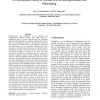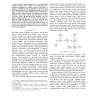292 search results - page 23 / 59 » Dormant program nodes and the efficiency of genetic programm... |
SOCO
2008
Springer
13 years 7 months ago
2008
Springer
Abstract We demonstrate a SIMD C++ genetic programming system on a single 128 node parallel nVidia GeForce 8800 GTX GPU under RapidMind's GPGPU Linux software by predicting te...
JPDC
2006
13 years 7 months ago
2006
Distributing data is a fundamental problem in implementing efficient distributed-memory parallel programs. The problem becomes more difficult in environments where the participati...
CORR
2010
Springer
13 years 7 months ago
2010
Springer
Multiprocessor task scheduling is an important and computationally difficult problem. This paper proposes a comparison study of genetic algorithm and list scheduling algorithm. Bo...
BIB
2008
13 years 7 months ago
2008
Short tandem repeats, specifically microsatellites, are widely used genetic markers, associated with human genetic diseases, and play an important role in various regulatory mecha...
CEC
2008
IEEE
14 years 2 months ago
2008
IEEE
—Genetic programming (GP), is a very general and efficient technique, often capable of outperforming more specialized techniques on a variety of tasks. In this paper, we suggest ...


